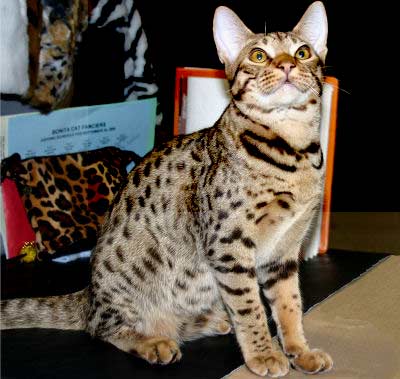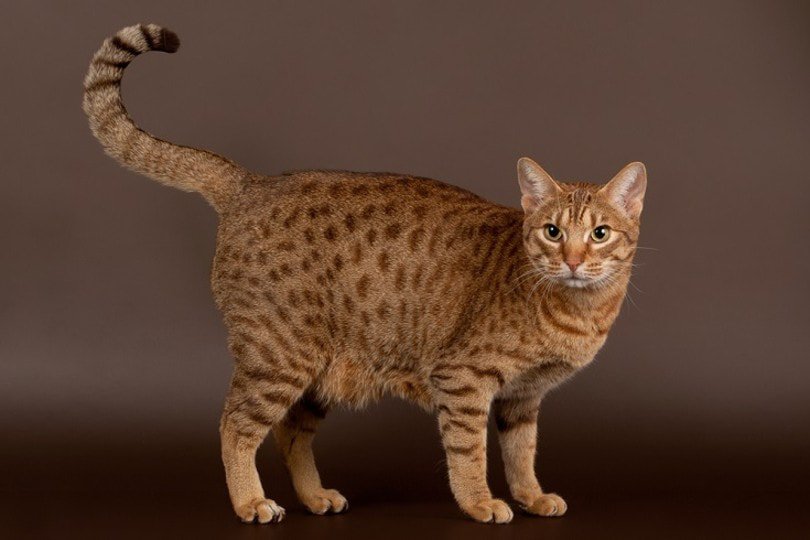
Ocicats are wild in appearance, but make great pet cats with a tame and loving character!
The Ocicat was an exciting, exotic development. This is one of the most unique hybrid cat breeds, having the alluring beauty of a wild cat but being an all domestic cat. Its coat has distinct spots on a light background, running from its ears to almost the tip of its tail. Its name, Octicat, is said to come from a combination of the resemblance to the wild Ocelot, and its earlier name Accicat. The name “Accicat” resulted from this cat being an accidental hybrid combination.
The first accidental cat with this spotted coat pattern was named Tonga, born in the 1960’s. Ms. Virginia Daly of Michigan was dabbling in hybrid crosses, mating a hybrid Abyssinian x Seal Point Siamese female with a Chocolate Point Siamese male. Tonga was a pretty little thing with an ivory colored coat topped with golden spots. Neither the kitten’s coat color nor its pattern were recognized at that time, so Tonga was neutered and sold as a pet. However this kitten sparked some curiosity. First Ms. Daly, and then other dedicated cat fanciers worked to try and selectively breed a a small, graceful, spotted domestic cat that resembled a wild cat.
The wonderful Ocicats seen in the United States today are the glorious results of these endeavors, with a few other additions. The American Shorthair cat, which is a natural cat breed, was introduced into the mix for additional colors and body size. There is also a Longhair Ocicat variation. Ocicats come in all Tabby cat colors as well as silvers, with contrasting well defined spots. Like the fur found on the Abyssinian’s, each hair has several bands of color except those at the very tip of the tail, which are usually black. The coat has a natural shine but is soft and short, making this a cat a low maintenance breed, needing only a weekly grooming.
The Ocicat offers an exotic appearance without any of the wild personality characteristics. They have a powerful look yet are neither cobby nor chunky. They are considered a moderate type cat, meaning they are medium-sized and well proportioned. They have muscular legs, strong paws, and a long tail. The head is wedge-shaped with moderately large ears, and large almond-shaped eyes. It also has a moderate voice.
The Ocicat is a high-energy cat that is very active and playful. They are highly social, but with an even temperament, and are also very durable with few health problems. Like the Siamese, they can attach to one person more than to others. They can also be dominant with other cats. The Ocicat is known for being unusually easy to train, and can be trained to use a leash. This breed makes a great family cat that has no special grooming, dietary, or health needs.
For information about keeping a pet cat, see:
Cat Care: How to Take Care of a Cat
- Kingdom: Animalia
- Phylum: Chordata
- Class: Mammalia
- Order: Carnivora
- Family: Felidae
- Genus: Felis
- Species: domesticus
Background
The Ocicat was accidentally first created by Virginia Daly in 1964 in Berkeley, Michigan. Virginia Daly was attempting to breed an Abyssinian-pointed Siamese by crossing a Chocolate Point Siamese male with a Seal Point Siamese and Abyssinian hybrid female. Surprisingly, the litter that was produced contained a golden-spotted male kitten. This kitten was named Tonga and was neutered and sold as a pet, since he did not fit into this particular breeding program. However, the prospect of a new spotted breed perked Virginia Daly’s interest, and she retained the further spotted kittens that were produced.
Another American breeder, Tom Brown began a long-term breeding program. Other breeders introduced the American Shorthair into the breeding programs, which increased the cat’s size. The Ocicat achieved championship status in the United States in 1987. It was introduced to Britain in the late 1980s. Also in the 1980’s, a separate European line of Ocicats was developed in Germany by Karen Dupuis.
This breed’s name is a cross between “Ocelot” and “Cat”, since it resembles an Ocelot, but is a domestic cat. Two names that were also used in the early years of this breed were “Ocellete”, since it resembles a small Ocelot, and “Accicat”, since its inception was an accident in another breeding program.
Description
The Ocicat has a large, long, and muscular body. It is neither stocky nor angular in appearance. The head is a modified wedge, slightly curved from the jaw to the cheek and is proportionate in size to the body. The eyes large and almond-shaped, and the ears are moderately large. All eye colors are acceptable for this breed, except blue. The legs are muscular and fairly long. The tail is moderately long, thin to medium in width, and slightly tapered. This breed weighs 6-14 pounds. The Ocicat’s lifespan is approximately 15 years.
The hair is short, fine, and silky. Like the Abyssinian’s fur, each strand has several bands of color. The hairs at the tip of the tail are the only ones that do not share this trait. The coat is spotted, with the most common color type being tawny, or light brown. Other variations include Chocolate, Cinnamon, Blue, Lavender, Fawn, Silver, Chocolate Silver, Cinnamon Silver, Blue Silver, Lavender Silver, and Fawn Silver.
Care and Feeding
The Ocicat should be fed a simple balanced diet with no special requirements.
Housing Your Cat
The Ocicat is an active cat that enjoys playing and exercising outside. However, if a yard cannot be provided, a large house or apartment with a terrace can suffice.
Maintenance
Ocicats require very little grooming. Their coat is short, fine, and naturally shiny. Weekly brushing is recommended, as it is for any low-maintenance cat.
Social Behaviors
Ocicats are social cats that do not like being alone. Like the Siamese, they can attach to one person more than to others. They can also be dominant with other cats.
Activities
The Ocicat is a naturally active breed that needs no coaxing to get its exercise. It should be provided with ample room to play and run. It should also be given many toys to play with inside, especially if it is kept indoors most of the time.
Breeding/Reproduction
Litters usually contain 4 to 6 kittens. Breeding generally occurs with no complications.
Common Health Problems
Ocicats are generally healthy with no special problems documented.
Availability
Ocicats are readily available from breeders that can be found on the internet or locally. Prices range from approximately $300 to $900.
References
- Animal-World References: Cat Breeds – Exotic Cats
- Hybrid Law, Hybridlaw.com
- Kurt Schmitt, Hybrid Cat Breeds, Cat Lovers Only, Copyright 2004 – 2011
- The Hybrid Cat Breeds of the World, Cat Breeds, Copyright 2009 – 2011
- Ocicat Cat Breed – Overview and History, PetWave Corporation, Copyright 2011
Featured Image Credit: dien, Shutterstock
